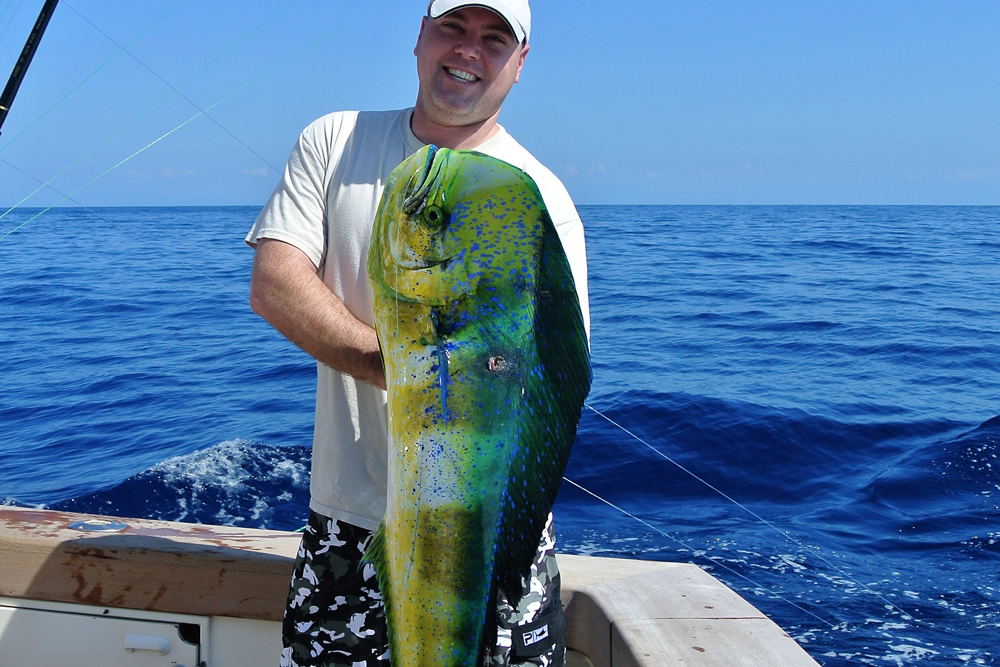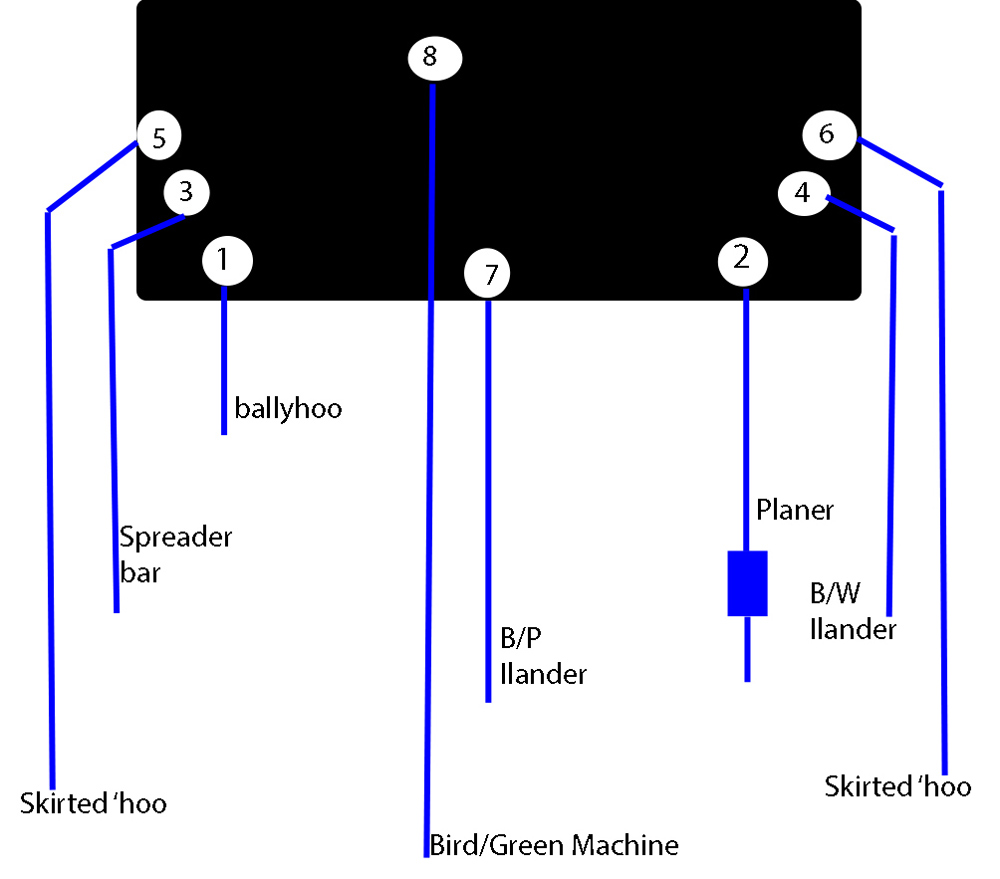Last month we looked at tips and tricks to save a slow day of offshore trolling, and this month, we'll look at how to set a mixed trolling spread. The list of items required to put an offshore trip together is extensive, and after all the effort and cost that’s required before the lines can even get wet, it would be nice to think we have a good chance of success. That age-old quote, “a bad day of fishing is better than a good day at work” will receive no argument from any fisherman. However, I'm sure we would all agree that a day catching fish is WAY better than a day at work! Success offshore requires advance tactical planning, and this is the first part of a three-part series on offshore trolling should be exactly what you need to make those plans and turn your next day of fishing into a day of catching.

Fishing Intel
Information is one of an anglers most important tools in the box. A blind chicken may find a piece of corn, but one that sees eats all day. Take the time to walk the dock the evening before you fish and observe what actually was caught by the charter and private boat fleets; seeing is believing. Often successful anglers are more than willing to share information after a day that put smiles on faces. Personally, I never minded answering a few questions after the charter departed and while cleaning gear after a long day offshore. However, don't ask for GPS numbers – keep questions generalized. Pay attention to what lures are being washed off or laying around in the pits. A bait store clerk gets to hear many stories of what was caught, where and how by customers. When picking up your ballyhoo, pick his or her brain. They want you to be successful, it’s good for business. Social media can provide information as well, although it’s often a couple days old. Finally, remember that you always have a source of current intel on our web site, at the FishTalkMag.com Reports – don’t forget, we update our reports every Friday, by noon!
The Offshore Spread
Anglers often leave the slip with intentions of catching tuna or marlin. But in all honesty, most anglers want action and to feel a bent rod after running offshore, even if it is not the intended quarry. There’s no way of knowing exactly what size or type pelagic will be lurking out on the edge of the Continental Shelf. And there is certainly nothing wrong with a kill box containing mahi, wahoo or Atlantic bonito, which are all excellent table fare (Atlantic bonito are the ones with sweet white flesh, not to be confused with false albacore). If you do want to strictly target tuna or marlin, the spread can be tailored to those species. Parts two and three of this series will drill down into targeting these two popular species. But for now, let's try to turn the fishing into catching any way we can – and to have the very best chance to get those rods bending, we’ll employ a mixed spread.
A mixed spread is just that, mixed, with different sizes, colors, and types of bait or lures. A spread can have any number of rods, with boat size and angler ability dictating just how many can be trolled without tangling. Though they’re mixed, these spreads should still be tailored depending on the season, location, and the pelagics currently available. For example; when wahoo are abundant in late season, anglers may want to make sure they have offerings of black/purple, black/blue or black/red in the spread, which are some of the wahoo’s favorite colors. Or when yellowfin are plentiful at the cleaning station, two spreader bars should be in the mix. If trolling inside on the 20-fathom line, king mackerel and bluefish will be possibilities and a couple spoons should replace the larger baits you might otherwise pull. Use the intel you gathered earlier to help determine just what goes into this mix.

Basic Eight Line Spread
Prior to tailoring your spread you need a starting point, and this basic eight-line spread is a great place to begin. On one flat line (1) run a small naked or short-skirted rigged ballyhoo approximately 17 to 20 feet behind transom. This is the closest line to the boat and the rigged ballyhoo must look natural, swimming just under the surface. In lieu of the other flat line (2), use a rod in conjunction with a planer. Rig with a five and a half inch Drone spoon (white or silver) or a black/purple Jr Ilander (if wahoo are around) skirted over a medium ballyhoo. This bait should be set above the thermocline at a depth of 20 to 60 feet (watch your fishfinder to see where fish are holding and if a thermocline is visible). If you’re not familiar with using a planer, a second flat line set with a six-inch single cedar plug (natural color or blue/white) or a cedar plug daisy chain 25 feet behind the transom is a good alternative. However, a deep bait is the preferred choice for this rod position.
One short rigger (3) will be a multi-colored spreader bar rigged with a green machine hook-bait. This will be positioned around 50' back, or as many anglers often refer to it, on the third to forth wave. The other short rigger (4) will be a blue/white Ilander skirted over a medium or large ballyhoo (go large if blue marlin are in the area) and set at 60 feet, on the forth to fifth wave.
The long riggers consist of two skirted ballyhoo. In early morning or low light conditions (cloudy) skirt one medium ballyhoo (5) in dark colors and set it at around 90 feet back. As the sun rises change this skirt to brighter colors (pink is a good choice). For the other long rigger (6) skirt a small ballyhoo in green/yellow at 125 feet. This is a good color for Mahi when trolling by flotsam or weedlines.
A “sweet spot” rod (7) is set in the center of the spread in-between the short and long rigger lines. Drag a black/purple Ilander skirted over a medium ballyhoo or use a small bird with daisy chain consisting of four- or five-inch pink chuggers to churn water in the middle of the spread.
Finally, a shotgun rod (8) drags a green bird with triple Green Machines about 50 feet farther back behind the long riggers. (If you're not familiar with this rig, you can see how it's made in Spring Offshore Fishing Tackle Prep). If bluefin are in area set this back even farther, at least 100 feet behind the long riggers.
Of course, this spread can and should be modified by increasing the number of rods or trying different lures, or baits such as rigged squid. Also, adjust the distance of the lines so the bait or lure runs on the front surface of boats’ wakes. Just keep in mind, until you know what the fish find to their liking on any given day, the whole idea of using a mixed spread is to identify what’s going to work best. Once this is determined, change up spread and present more of the offerings that are getting hits.
Many anglers have the notion that teasers and dredges are only for billfishing, but this is a mistake. They are important weapons in the offshore arsenals, attracts all types of pelagic, and should be utilized at all times – including with mixed spreads. Their usage will be address in detail, during part three of this series.
- By John Unkart. For information on how to rig planers and or other techniques mentioned in article, check out John Unkart's book “Offshore Pursuit.”